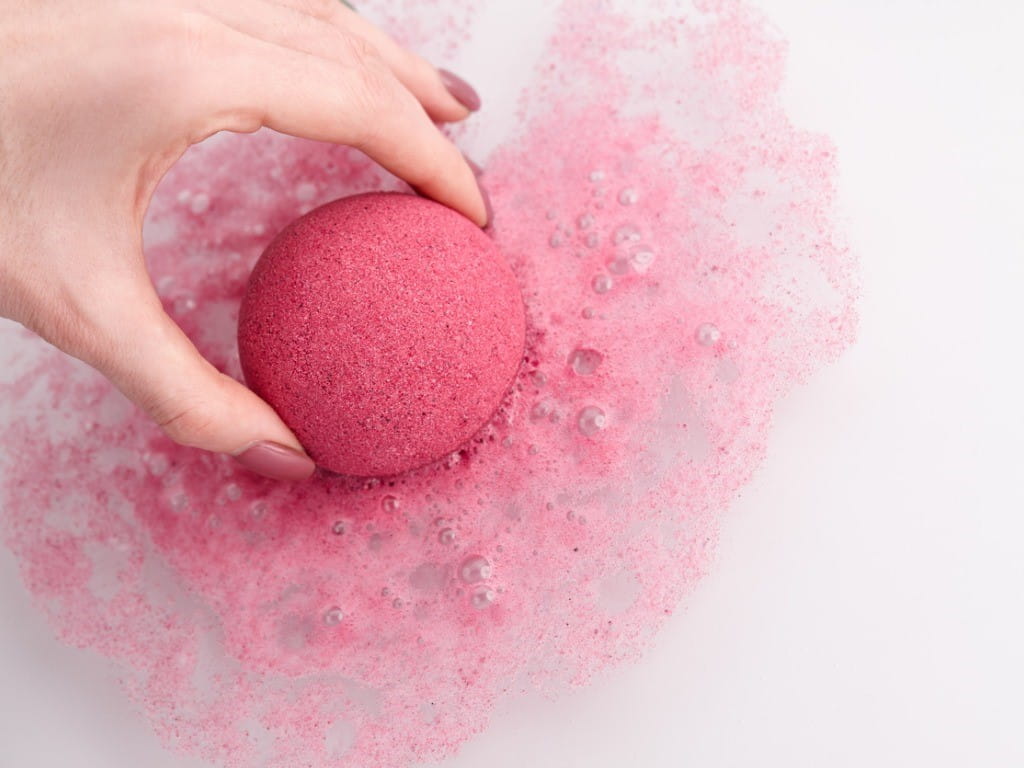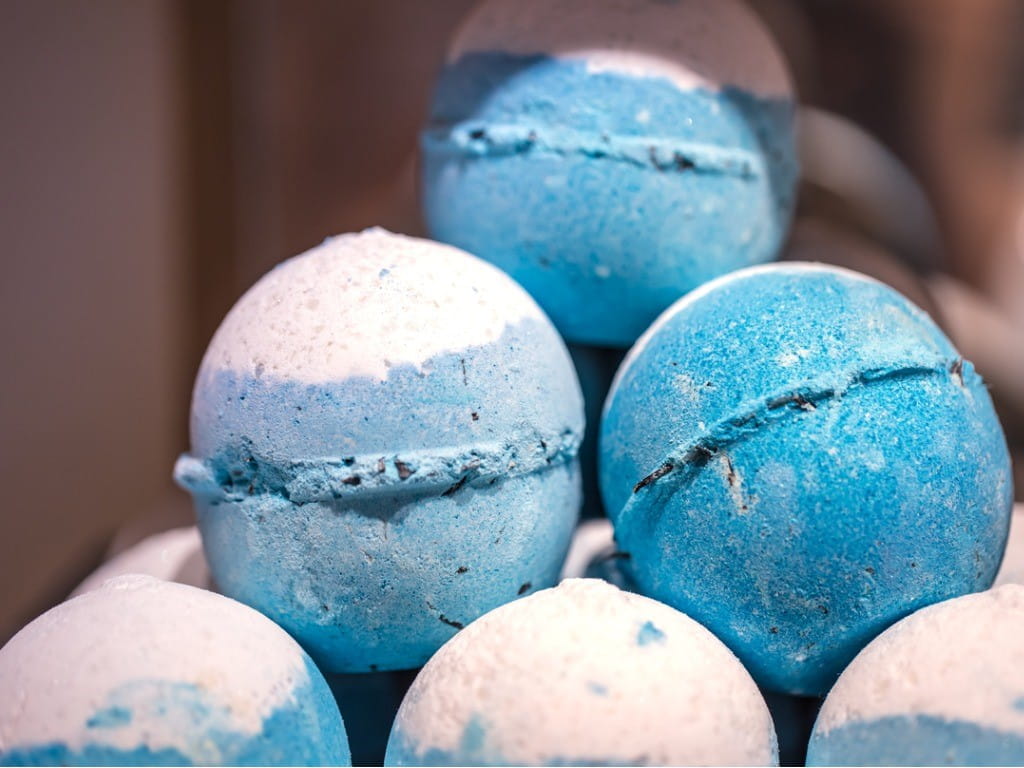The Baby Ate a Bath Bomb!

The Bottom Line
When used as directed, bath bombs and bath fizzies are safe. Skin irritation can occur in some people, and eye irritation is expected to occur if splashed in the eyes. Unintentional ingestion of small amounts is expected to cause minor effects such as oral irritation, nausea, vomiting, and diarrhea.

What are bath bombs?
Bath bombs and bath fizzies are very similar. These products are available in granules (“fizzies") or, more commonly, hard-packed dry ingredients (“bombs”). The most common bath bombs are spherical, but they are also available in a variety of other shapes, such as flowers, sea shells, and even bakery items. Many cupcake- and donut-shaped bath bombs look good enough to eat, so it should be no surprise when a toddler takes a bite.What are in bath bombs? How do they work?
The ingredients that make these bath products fizz are sodium bicarbonate and citric acid. Sodium bicarbonate is also known as baking soda. Citric acid is a weak acid found in citrus fruits. When these dry ingredients dissolve in water, they react, and lots of carbon dioxide bubbles are released over several minutes as the bath bomb breaks apart. Other ingredients that might be included are soaps, oils, butters, mineral salts, fragrances, dyes, flower petals, and glitter.Are bath bombs good for you?
Some companies suggest that their bath bombs have detoxifying properties or provide other health benefits such as pain relief, but there is little evidence to back these claims. Some bath bombs include salt magnesium sulfate, a mineral commonly known as Epsom salt. For years, soaking in a tub with Epsom salt has been promoted as a way to increase magnesium in the body, which would relieve a variety of ailments such as sore muscles, cramps, and stress. While there are anecdotal reports of health benefits, the claims are not backed by good science. Magnesium is not well absorbed through the skin, so there are no internal benefits from the magnesium salt in the bath water. Any relief of muscle soreness is probably a result of the warm water. Don’t believe the hype; just enjoy the bath.
Products with ingredients such as cocoa butter and almond oil can provide temporary relief of dry skin. These kinds of moisturizers are also found in traditional bath oils and body lotions. In addition to the fizzing ingredients, the fragrances, dyes, botanicals, and glitter are intended to enhance the bathing experience. There are several recipes for homemade bath bombs that contain many of the same ingredients found in commercially prepared products.
Are bath bombs safe?
When used as directed, bath bombs are generally safe. The main concern is skin sensitivity to some of the ingredients, such as fragrances and dyes. Even "natural" fragrances obtained from plants, such as limonene and linalool, are known to cause allergic dermatitis.
People with sensitive skin should probably not use bath bombs. Not all products recommend rinsing off the skin after using, but it is a good practice to remove residual chemicals or glitter from sensitive places. The bathtub will benefit from a cleaning as well, although your plumber might object to rinsing solid material, such as flower petals, down the drain.
Is it safe to swallow bath water that contains a bath bomb?
Unintentionally swallowing a small amount of bath water with a dissolved bath bomb should not be dangerous because the ingredients would be very diluted. Similarly, contact between the bath water and the eyes should also be well-tolerated. Direct contact of the granules or powder with the eyes can produce irritation that should resolve after a thorough rinsing with water.Are bath bombs toxic if ingested?
The bright colors and food shapes of many bath bombs can be attractive to toddlers, so unintentional ingestions should be expected. Once a piece of a bath bomb contacts the moisture in the mouth, it will begin to make carbon dioxide bubbles just as if it were dropped into bath water. Hopefully, this will make a toddler spit it out. If a piece of a bath bomb is swallowed, there is a risk that the rapid formation of carbon dioxide gas could stretch or even rupture the stomach.
The most toxic ingredient in these products is sodium. Sodium, also found in table salt, can cause dangerous body-wide effects such as confusion, coma, and muscle weakness in excessive amounts. Most commercially available products do not list the sodium composition, so a toxic amount of a product is hard to determine. Instead recommendations are based on the worst-case-scenario for each bath bomb. It is reasonable to assume that a toddler ingesting a taste, a lick, or a few small granules would not swallow enough to cause concerning body-wide effects. The other ingredients are less toxic, so they would take a much larger amount ingested to be a problem.
Some of the ingredients can be irritating to the mouth and stomach, so nausea and vomiting are possible. Products containing magnesium sulfate can cause diarrhea. Many of the ingredients would be considered non-toxic, such as flower petals and glitter. The symptoms resulting from swallowing small amounts of these bath products should be mild and usually can be managed at home. Ingestions of larger amounts have the potential to cause serious effects, and medical management at a healthcare facility might be needed.
I think my child ingested a bath bomb. What should I do?
Treatment for ingestion of any of these products is rinsing out the mouth and drinking a few sips of water to clear the mouth and throat. Mild vomiting and diarrhea can be managed at home by slowly sipping water to stay hydrated. Eye exposures should immediately receive a 15-minute irrigation with room temperature water.
If you suspect someone has ingested bath fizzies or bath bombs, have them rinse out their mouth and drink a few sips of water. Then, check the webPOISONCONTROL online tool for further guidance or call Poison Control at 1-800-222-1222.
Karen D. Dominguez, PharmD
Certified Specialist in Poison Information
Revised William G. Troutman, PharmD
Professor of Pharmacy Emeritus
Poison Control Media Information
Did you find this page helpful? If so, we need your support. Poison Control is in constant competition with misinformation online. Links to www.poison.org or our webPOISONCONTROL triage tool from other websites and blogs help internet searchers quickly find accurate information and Poison Control’s contact information in an emergency. If you use the content from this page, please provide attribution via a link back to this page, www.poison.org, or https://triage.webpoisoncontrol.org/#!/exclusions. By doing so, you could save a life. Thank you!
Poisoned?
Call 1-800-222-1222 or
Prevention Tips
- Use bath bombs and fizzies according to the instructions on the product label.
- Keep bath products out of the reach of children.
- Supervise children using these products in their baths.
- Rinse the skin after bathing with these products.
- Do not place bath products near food products.
This Really Happened
The mother of a 15-month-old girl called Poison Control because her daughter took a bite of a bath bomb. The girl quickly spit out the piece but had bubbles in her mouth. The girl's mouth was rinsed out and she was fine. The amount involved was small enough that she could be watched at home for minor mouth or throat irritation. A few sips of water were recommended. A follow-up call to the mother was made, and the little girl did not develop any effects.
For More Information
References
Poisoned?
Call 1-800-222-1222 or
Prevention Tips
- Use bath bombs and fizzies according to the instructions on the product label.
- Keep bath products out of the reach of children.
- Supervise children using these products in their baths.
- Rinse the skin after bathing with these products.
- Do not place bath products near food products.
This Really Happened
The mother of a 15-month-old girl called Poison Control because her daughter took a bite of a bath bomb. The girl quickly spit out the piece but had bubbles in her mouth. The girl's mouth was rinsed out and she was fine. The amount involved was small enough that she could be watched at home for minor mouth or throat irritation. A few sips of water were recommended. A follow-up call to the mother was made, and the little girl did not develop any effects.
